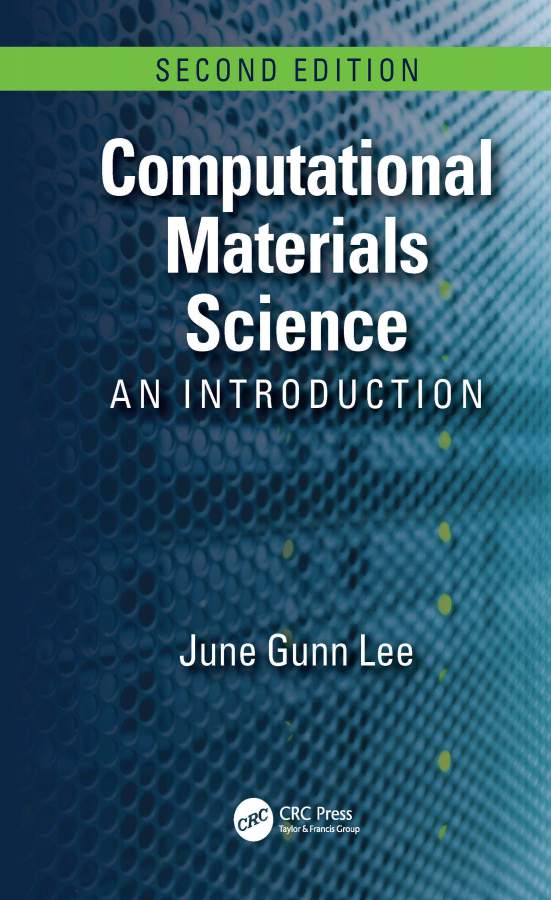Computational Materials Science An Introduction, Second Edition
出版社: CRC Press; 2 (2016年12月1日)
精装: 375页
语种: 英语
ISBN: 1498749739

介绍
This book covers the essentials of Computational Science and gives tools and techniques to solve materials science problems using molecular dynamics (MD) and first-principles methods. The new edition expands upon the density functional theory (DFT) and how the original DFT has advanced to a more accurate level by GGA+U and hybrid-functional methods. It offers 14 new worked examples in the LAMMPS, Quantum Espresso, VASP and MedeA-VASP programs, including computation of stress-strain behavior of Si-CNT composite, mean-squared displacement (MSD) of ZrO2-Y2O3, band structure and phonon spectra of silicon, and Mo-S battery system. It discusses methods once considered too expensive but that are now cost-effective. New examples also include various post-processed results using VESTA, VMD, VTST, and MedeA.
作者简介
June Gunn Lee is an emeritus research fellow in the Computational Science Center at the Korea Institute of Science and Technology, where he has worked for 28 years. Currently, he is also lecturing at the University of Seoul. He has published about 70 papers on engineering ceramics and computational materials science. He received his M.S. and Ph.D. in Materials Science and Engineering from the University of Utah, U.S.A.
目录
Preface
Chapter 1 Introduction
1.1 Computational Materials Science
1.2 Methods in Computational Materials Science
1.3 Computers
References
Chapter 2 Molecular Dynamics (MD)
2.1 Introduction
2.2 Potentials
2.3 Solutions for Newton’s Equations of Motion
2.4 Initialization
2.5 Integration and Equilibration
2.6 Data Production
Homework
Further Reading
References
Chapter 3 MD Exercises with XMD and LAMMPS
3.1 Potential Curve of Al
3.2 Melting of Ni Cluster
3.3 Sintering of Ni Nano-particles
3.4 Speed Distribution of Ar Gas: A Computer Experiment
3.5 SiC Deposition on Si(001)
3.6 Yield mechanism of Au Nano-wire
3.7 Water Nano-droplet Wrapped by Graphene Nano-ribbon (GNR)
3.8 Stress-strain Behavior of Si-CNT Composite
Homework
References
Chapter 4 First-Principles Methods
4.1 Quantum Mechanics: The Beginning
4.2 Schrödinger’s Wave Equation
4.3 Early First-principles Calculations
Homework
Further Reading
References
Chapter 5 Density Functional Theory (DFT)
5.1 Introduction
5.2 Kohn-Sham (KS) Approach
5.3 Kohn-Sham (KS) Equations
5.4 Exchange-correlation (XC) Functionals
5.5 Solving Kohn-Sham (KS) Equations
5.6 DFT Extensions and Limitations
Homework
Further Reading
References
Chapter 6 Treating Solids
6.1 Pseudo-potential (PP) Approach
6.2 Reducing the Calculation Size
6.3 Bloch Theorem
6.4 Plane-wave (PW) Expansions
6.5 Some Practical Topics
6.6 Practical Algorithms for DFT Runs
Homework
Further Reading
References
Chapter 7 DFT Exercises with VASP
7.1 VASP (Vienna ab-initio Simulation Package)
7.2 Pt-atom
7.3 Pt-FCC
7.4 Convergence Tests
7.5 Pt-bulk
7.6 Pt(111)-surface
7.7 Nudged Elastic Band (Neb) Method
7.8 Pt(111)-catalyst
7.9 Band Structure of Silicon (Si)
7.10 Band Structure of Silicon (Si)-HSE06
7.11 Phonon Calculation for Silicon (Si)
7.12 W12C9-Co28-interface
7.13 Li2MnO3 Battery System with GGA+U Method
7.14 Using GUI for VASP Calculations
Homework
References
Appendix
Appendix 1 List of Symbols and Abbreviations
Appendix 2 LINUX Basic Commands
Appendix 3 Convenient Scripts
Appendix 4 The Greek Alphabet
Appendix 5 SI Prefixes
Appendix 6 Atomic Units
Index




 京公网安备 11010802022153号
京公网安备 11010802022153号
顶一下,感谢分享!
顶一下,感谢分享!
顶一下,感谢分享!
顶一下,感谢分享!
顶一下,感谢分享!
谢谢分享,
顶一下,感谢分享!